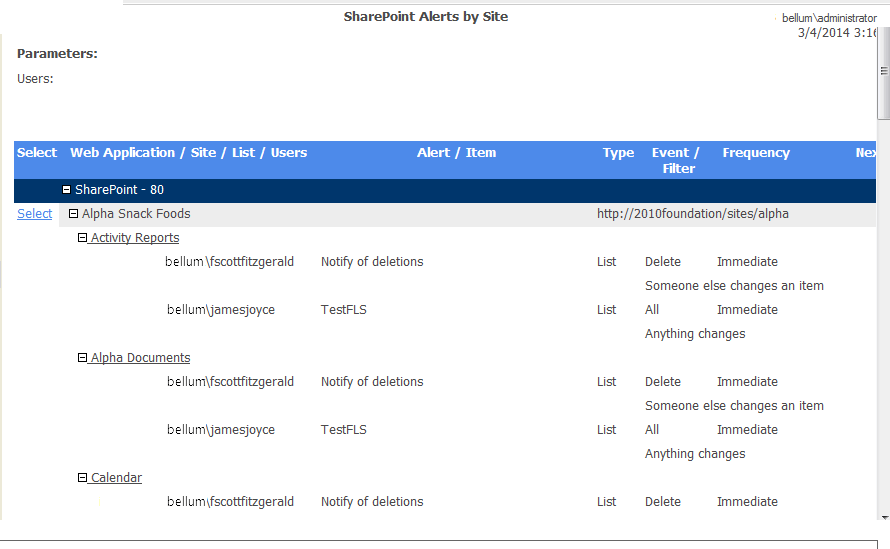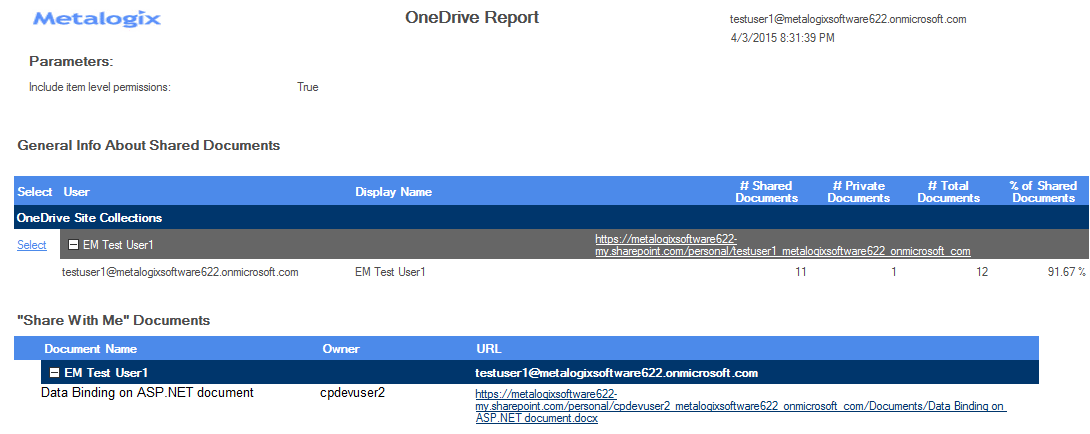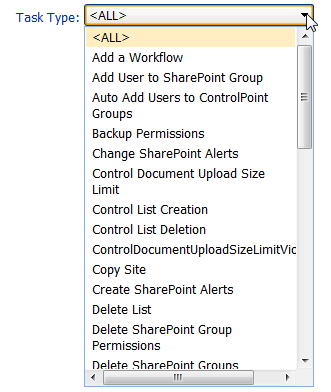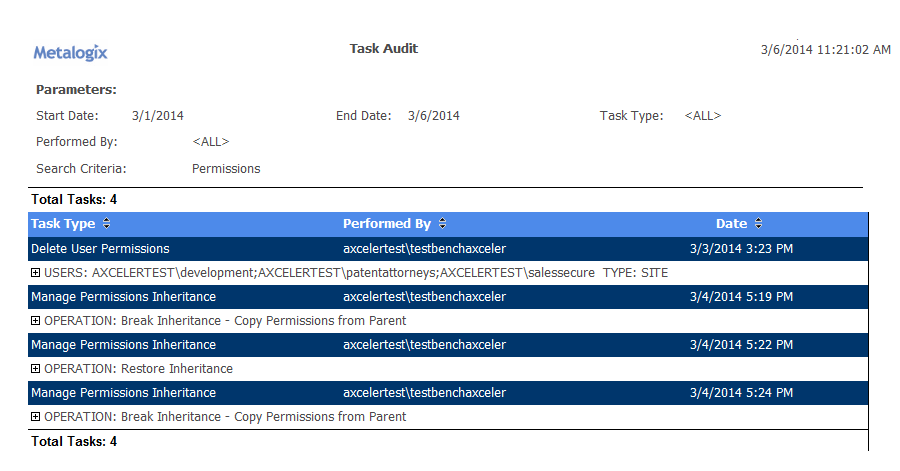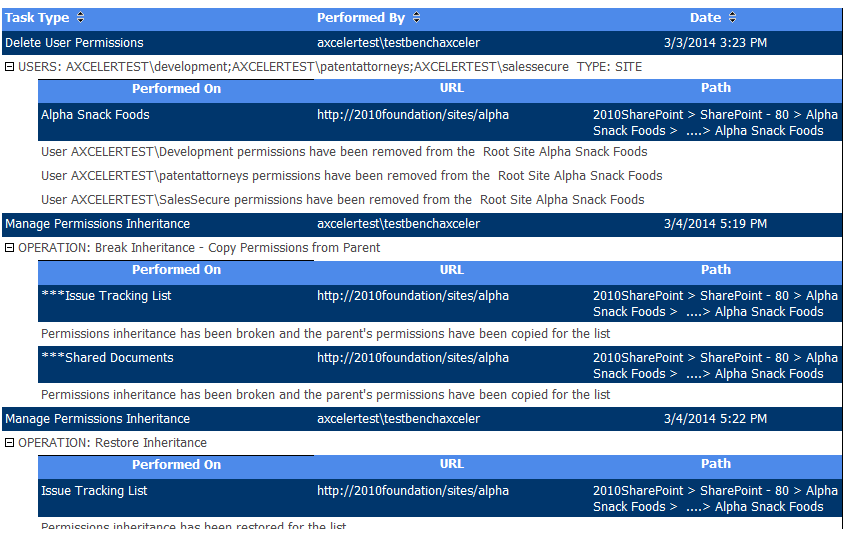Analyzing SharePoint Alerts by Site
The SharePoint Alerts by Site analysis provides the following information about SharePoint alerts that have been set within one or more selected sites:
·the user for whom the alert was set
·the list or item on which the alert was set
·alert properties (including event type and frequency), and
·the date and time of the next alert.
To generate a SharePoint Alerts by Site analysis:
1Select the object(s) you want to include in your analysis.
2Choose Audits and Alerts > SharePoint Alerts by Site.
3Specify the parameters for your analysis.
Now you can:
·run the operation immediately (by clicking the [Run Now] button)
OR
·schedule the operation to run at a later time or on a recurring basis.
OR
·save the operation as XML Instructions that can be run at a later time.
The top level of analysis results lists all of the Web applications within the scope of your analysis.
When expanded, a list of sites on which alerts have been set displays, along with the following detail about each alert:
·the Site for which the alert was created
·the Titles of the list, and if applicable, item, for which the alert was set
·each of the Users for whom the alert was set, along with:
§the title of the Alert
§the alert Type (List or Item)
§the Event that triggers the alert and, if the alert was created for an item, the Filter (that is, the option selected for "Send Alerts for These Changes")
§the Next Alert date and time
Analyzing SharePoint Alerts by User
The SharePoint Alerts by User analysis provides the following information about SharePoint alerts that have been set for one or more users:
·the site within which the alert was set
·the list or item on which the alert was set
·alert properties (including event type and frequency), and
·the date and time of the next alert.
To generate an Alerts by User analysis:
1Select the object(s) you want to include in your analysis.
2Choose Audits and Alerts > SharePoint Alerts by User.
3Specify the parameters for your analysis .
Now you can:
·run the operation immediately (by clicking the [Run Now] button)
OR
·schedule the operation to run at a later time or on a recurring basis.
OR
·save the operation as XML Instructions that can be run at a later time.
When expanded, each Site for which alerts have been created displays, along with the following detail about each alert:
·the title of the Alert
·the List and (if applicable) Item on which the alert was created
·the alert Type (List or Item)
·the Event Type that triggers the alert
·the Frequency of the alert as well as the Next Alert date and time
·if the alert was set for an item, the Filter used (that is, the option selected for "Send Alerts for These Changes")
Generating a OneDrive Summary Report
If you The OneDrive Summary report lets you view OneDrive for Business usage information for personal sites to which you have administrator privileges, including "Share With Me" documents.
To generate this report, the ControlPoint Application Administrator must explicitly choose to include OneDrive site collections in the SharePoint Hierarchy. (However, doing so may significantly increase SharePoint Hierarchy load time, especially if there are a large number of OneDrive site collections in the environment.) Contact Quest Support for details.
To generate a OneDrive Summary Report:
1.Select the OneDrive site collection(s) (or the OneDrive Site Collections node if you want to include all OneDrive site collections that you administer).
2Choose OneDrive > OneDrive Summary.
3If you want to Include item level permissions, check this box.
NOTE: If you choose this option, processing time may increase, especially if the scope of your selection contains a large number of site collections and/or documents.
Now you can:
·run the operation immediately (by clicking the [Run Now] button)
OR
·schedule the operation to run at a later time or on a recurring basis.
OR
·save the operation as XML Instructions that can be run at a later time.
Analysis results include the following information about each OneDrive site collection in the scope of your selection:
·the following General Info About Shared Documents:
§the owner of the site collection
§the document name, owner, and URL of each "Share With Me" document on the selected site(s).
§If you chose to Include item level permissions, the following additional information displays
·# Shared Docments
·# Private Documents
·# Total Documents
·% of Shared Documents
·the name, owner, and URL for "Share With Me" Documents.
The ControlPoint Task Audit
The ControlPoint Task Audit is an analysis tool that summarizes one or more of the ControlPoint actions that have been performed by administrators over a specified time period.
By default, the Task Audit report is accessible from the Manage ControlPoint panel. An action-specific Task Audit Report is also displayed automatically after a ControlPoint action is carried out.
NOTE: In a multi-farm installation, the Task Audit includes actions performed on both home and remote farms.
To generate a Task Audit:
1From the Manage ControlPoint panel, choose Schedule Management and Logging > ControlPoint Task Audit.
2Specify the following parameters for your analysis:
§Either
§Enter the StartDate and EndDate, or
§click the Calendar icon (
§(Optional) If you want to search for a specific text string, complete the Search for field. You can enter a full or partial:
§site name or url
§action name, or
§action description
For example, by entering the words "Site Theme" in the Search for field, your results will be limited to tasks that involved modifying a site theme.
Select an Administrator from the drop-down. (If you want report results to include all administrators in the list, select <ALL>).
Note that the drop-down list includes only administrators who have performed a ControlPoint action within that farm.
§Select a Task Type from the drop-down.
NOTE: The Task Type list is populated with the types of actions that have actually been performed by administrators. For example, if a Delete User Permissions action has never been performed, it will not appear in the list. If you want to include all available options in the report results, select <ALL>.
If you chose the Run Now, option, after the operation has been processed:
·a confirmation message displays at the top of the page, and
·a ControlPoint Task Audit is generated for the operation and displays in the Results section.
If you schedule the operation, a link to the Task Audit is included in the scheduled action notification email.
See also The ControlPoint Task Audit.
Information in the Task Audit Report
The Task Audit Report contains the following information for each task:
·the Task Type
·the username of the administrator that the task was Performed by
·the Date and time when the task was performed, and
·a summary of the parameters chosen for the action.
When expanded, a more detailed description of a task displays, which lists:
·site collections or sites on which the action was carried out, and
·any special notes or errors (such as "Security is inherited - no processing is done").
Note that:
·As with other ControlPoint analyses, only actions taken on sites you have permissions to manage within ControlPoint display in audit report results.
·Sites for which the administrator who performed the action does not have permissions to manage are not acted upon, and therefore are not captured in the audit report.

